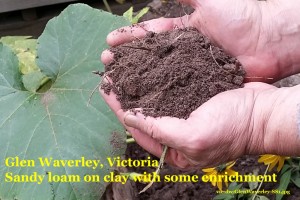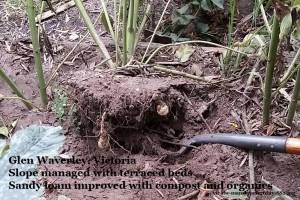Sandy loam on clay ‘Tree house’ garden soils for backyard permaculture family farm, Glen Waverley, Victoria, Australia

 Description: Three different adjacent sandy loam topsoils over clay subsoil bases
Description: Three different adjacent sandy loam topsoils over clay subsoil bases
in different beds
Soil 1 . Sandy loam ≈ 250 mm deep on upper terrace, slightly enriched, most organic
Soil 2 . Sandy loam, 150≈200 mm deep on mid-terrace, unimproved, lowest in nutrients
Soil 3 . slightly heavier sandy loam 250≈300 mm deep, organic mountain soil and cow manure added
 Location: sloping backyard in east Melbourne suburb
Location: sloping backyard in east Melbourne suburb
beds divided into terraces by soil type*
Values for this soil:
– Urban family farming: Fresh foods from the backyard for family and friends eg artichokes, pumpkins.
– Knowledge : by experimentation to find the best improvements for the soil
eg results from the artichokes experiments in 2015:
the imported and improved Soil 3 grew the most and largest;,
the most organic Soil 1 was variable but good;
the unimproved Soil 2 was also variable but produce less and smaller plants than soils 3 & 1
Challenges of the original clay soil to grow fresh food – managed by permaculture principles:
– Hill side slope- garden is divided into terraces which reduces erosion and aids watering
– Nutrient replenishment – organically sourced to add healthier topsoil over clay.
– Mediterranean climate (dry, hot summers)– watering as needed
– Experimentation – learning what works best!
* See more about
– what this soil produces and how at Tree House Family Farm Snapshot
– a bayside suburban clay based soil producing food for its family at Williamstown lemons.
– permaculture managements of soils on slopes in the French pre-Alps in Koute de Tyon hillside and on volcanic slopes on M’fango Island, Kenya.
![]()
Credits: Dennis Williamson, of Glen Waverley, gives permission for the photos and information to be used under a (cc) license 2015
Editing and page created by Jeanie Clark, enviroed4all®, Warracknabeal, for use in education under a (cc) licence 2015
return to Soil Selifes location page
page set up 25 November 2015, updated 9 January 2016
